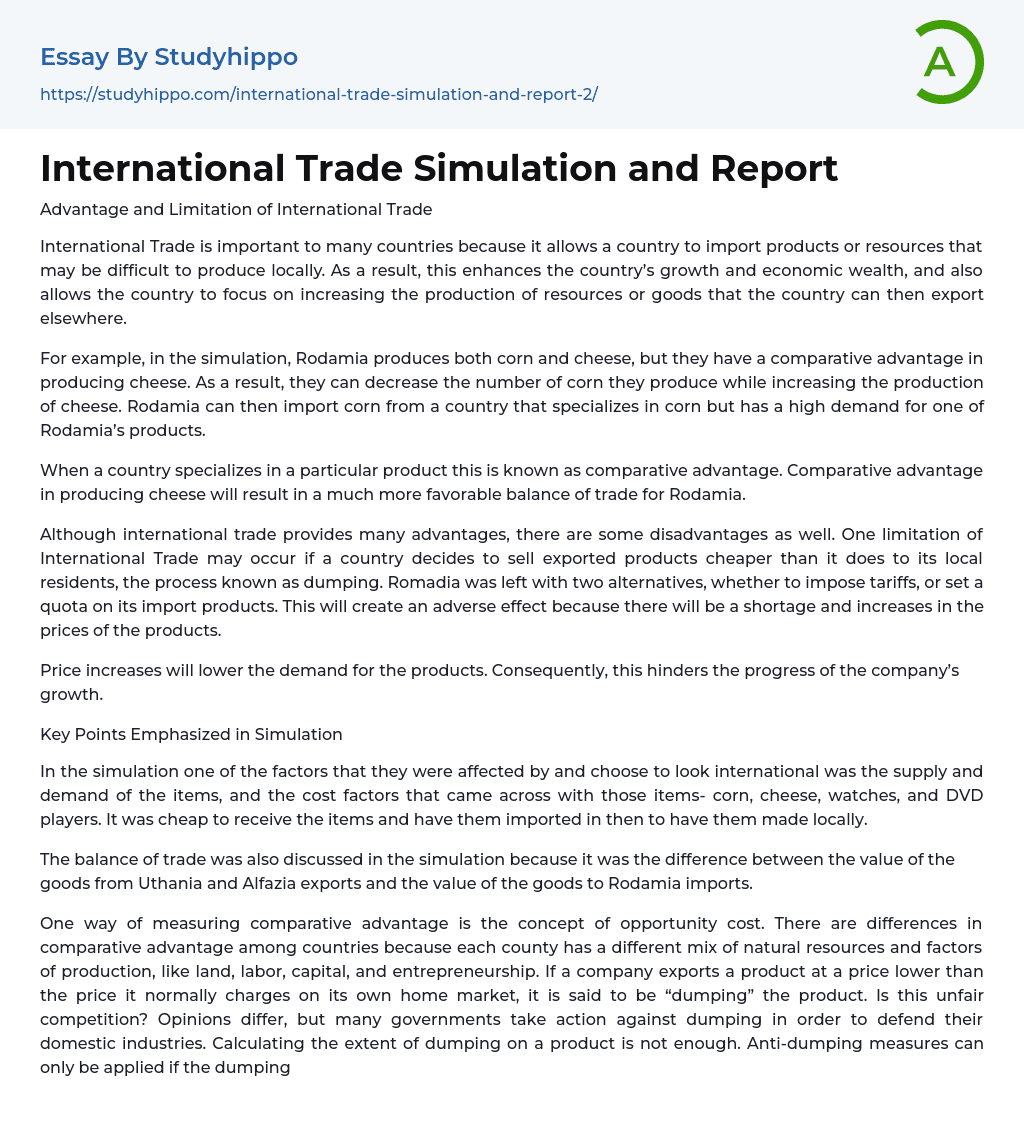Advantage and Limitation of International Trade
International Trade is advantageous as it allows countries to access products or resources that are difficult to produce domestically. This helps promote economic growth by enabling countries to focus on increasing the production of goods or resources that they can export. In the simulation, Rodamia excels in producing cheese but struggles with corn production. Therefore, they can decrease corn production and increase cheese production. As a result, Rodamia can import corn from a country specializing in its production while meeting the high demand for one of their own products.
Specializing in a specific product is called comparative advantage, and it leads to a more favorable trade balance for Rodamia when it comes to cheese production. While international trade has numerous benefits, there are also drawbacks. An example of such a l
...imitation is the practice of selling exported products at a lower price than what is charged to local residents, known as dumping. In response to this situation, Romadia had to choose between implementing tariffs or setting import quotas. Both options would have a negative impact, resulting in product shortages and price increases.
The increase in prices has the effect of decreasing demand for products, thereby hindering the company's growth. One important aspect highlighted in the simulation was the influence of supply and demand on international trade. The simulation analyzed the cost factors related to various items such as corn, cheese, watches, and DVD players. It was discovered that importing these items was more economical than producing them locally. Additionally, the simulation covered the topic of balance of trade, which represents the disparity between Uthania and Alfazia exports' value and Rodami
imports' value. Furthermore, the concept of opportunity cost was emphasized as a means to measure comparative advantage.
The differences in comparative advantage among countries arise from their unique combinations of natural resources and factors of production, such as land, labor, capital, and entrepreneurship. When a company sells a product to another country at a price lower than its domestic charge, it is considered "dumping" the product. Whether this constitutes unfair competition depends on varying opinions. Nevertheless, many governments take action against dumping to protect their domestic industries. Merely determining the extent of dumping on a product is insufficient; anti-dumping measures can only be implemented if the dumping negatively affects the importing country's industry.
Absolute and Comparative Advantage
If one country can produce a good more efficiently or with higher productivity compared to another country, it possesses an absolute advantage in producing that good.
The concept of absolute advantage is a relative term that involves comparing economic units. It involves comparing the productivity of industries across different countries. The theory of absolute advantage, which was developed by David Ricardo and, to some extent, John Stuart Mill, is credited with the development of theories of absolute and comparative advantage. Adam Smith's ideas on international trade also contributed to the development of these theories (Economypedia, March 18, 2009). If a country can produce a product at a lower opportunity cost compared to another country, it is said to have a comparative advantage in the production of that product (Int’l Trade Theory and Policy, July 18, 2006). Comparative advantage is used to determine the potential welfare that can be gained from trade and specialization.
Foreign Exchange Rate Foreign Exchange, like any other commodity,
is prone to price fluctuations. Several factors contribute to these fluctuating exchange rates. One such factor is international trade, which impacts the currency value. Nations with high exports or imports tend to witness changes in their Forex standards. Countries that export a significant amount of goods and services usually experience an appreciation in their currency value. Conversely, countries with higher imports see a decline in the value of their currency since they spend more on trading partners than they receive in return. Exchange rates are also influenced by political and psychological factors. Some currencies have a tendency to exhibit specific behaviors, such as the Swiss franc being considered a refuge currency.
The US Dollar is frequently considered a more secure currency in the midst of worldwide political crises. Speculation often impacts the value of currency, particularly when there is a perception that an economy is experiencing excessive growth and devaluation is imminent. During these instances, speculators typically withdraw their funds, resulting in an excess supply of the currency on the Forex market and leading to its depreciation.
World Trade Organization
The World Trade Organization (or "WTO") functions as an international cooperative organization providing a forum for discussions on global trade.
- American Dream essays
- Barriers To Entry essays
- Capitalism essays
- Central Bank essays
- Compensation essays
- Consumerism essays
- Economic Development essays
- Economic Growth essays
- Economic Inequality essays
- Economic System essays
- Economy essays
- Employment essays
- Export essays
- Finance essays
- Free Trade essays
- Gross Domestic Product essays
- Human Development essays
- Income Inequality essays
- Industry essays
- Inflation essays
- International Business essays
- International Trade essays
- Macroeconomics essays
- Materialism essays
- Max Weber essays
- Microeconomics essays
- Minimum Wage essays
- Monetary Policy essays
- Monopoly essays
- Pricing essays
- Profit essays
- Recession essays
- resources essays
- Taxation essays
- Trade essays
- Unemployment essays
- Warehouse essays
- World economy essays
- Activism essays
- Communism essays
- Conservatism essays
- Liberalism essays
- Marxism essays
- Nationalism essays
- Patriotism essays
- Policy essays
- Public Policy essays
- Social Contract essays
- Socialism essays
- Totalitarianism essays




